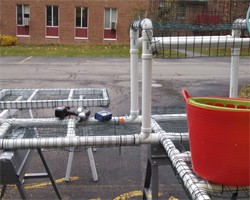Material List and Cost Calculator for Building a Wash Table and Aerator
Robert Hadad, Extension Vegetable Specialist
Cornell Vegetable Program

Our model wash table was built from parts purchased entirely from a decently stocked hardware store. The list contains all the components we used to build the main table, the side modular tables, and the "dirty table". Also listed are the prices we paid to give you an idea of a building price. The real goal for these tables is to demonstrate that it doesn't require high priced equipment to get started in setting up an easily cleanable wash line set-up. The idea is to have something usable whether it is indoors or outside under canopies. The key is having the tables and equipment that can be easily cleaned and sanitized while being low-cost, easy to build, and totally functional.
There is a second page of the spreadsheet that includes the materials list and cost for building an aerator. The concept of the aerator is to pump air in a tank of water that can agitate leafy greens or heads of lettuce, escarole, etc. to quickly remove soil and debris as well as keeping any added sanitizer in the water to reach in around the produce. The Jacuzzi motor was found at a spa parts website. I ordered a 1 hp model. Very quickly we realized that this was too powerful for any tank or basin less than 50 gallons or greater and needs high sides. A 7/8 hp motor or something smaller would work fine. The motor purchased had a 2" diameter exhaust that fit easily to a 2" PVC pipe. Do not glue the PVC pieces in the bottom of the tank together totally. The unit will suck in soil and debris when you turn off the motor after use and will need cleaning after each day's use. Having the PVC pipes in the bottom of the tank fit snuggly with the inside perimeter will help in keeping the unit from floating when the motor is turned on. More holes drilled into the PVC would help reduce floating. Using an easily cleanable weighted object to hold down the pipes can also work. To see the aerator in action, go to our video and the last couple of minutes of the video is on the aerator.
Wash Station Material List, Budget, and Notes (xlsx; 739KB)
- Download this Excel file to calculate the cost to build a wash table.

Upcoming Events
2026 Finger Lakes Produce Auction Winter Growers Meeting
January 8, 2026
Penn Yan, NY
At this vegetable grower-focused meeting, ag industry experts will discuss food safety, disease management in strawberries, the benefits of using cover crops, plus more. Two grower panel discussions will focus on pest management techniques and irrigation. DEC recertification credits offered in categories 10, 1a, 21, 22, 23, and 24.
2026 Ontario Produce Auction Winter Growers Meeting
January 14, 2026
Stanley, NY
At this grower-focused meeting, ag industry experts will discuss European Cherry Fruit Fly, greenhouse phytosanitary inspections, the benefits of using cover crops, plus more. Two grower panel discussions will focus on pest management techniques. DEC recertification credits offered in categories 10, 1a, 22, 23, and 24.


































